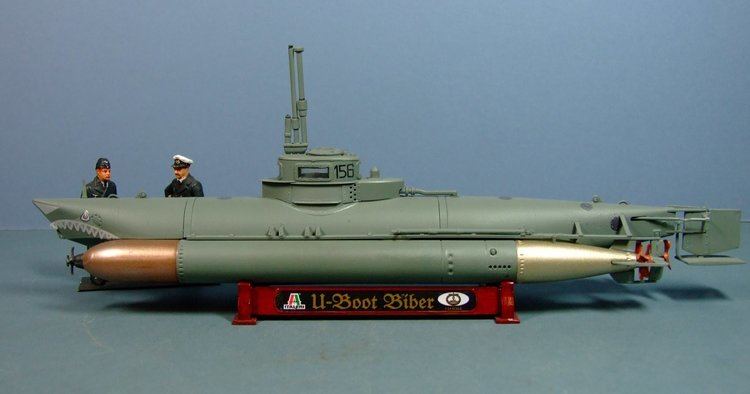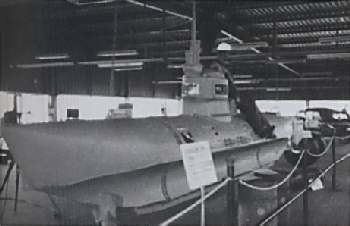Name Biber Length 8.9 m Displacement 5,700 kg Range 185,200 m | Height 1.6 m (5 ft 3 in) Weight 5.7 tons Beam 1.57 m | |
 | ||
Propulsion 32 hp (24 kW) Otto petrol engine, 13 hp (9.7 kW) electric motor, Speed 6.5 knots (12.0 km/h) surfaced5.3 knots (9.8 km/h) submerged | ||
The Biber (German for "beaver") was a German midget submarine of the Second World War. Armed with two externally mounted 21-inch (53 cm) torpedoes or mines, they were intended to attack coastal shipping. They were the smallest submarines in the Kriegsmarine.
Contents
- Development
- Design
- Operation
- Fcamp harbour
- Operations in the Scheldt Estuary
- Attempted attack on Vaenga Bay
- Further developments
- Surviving examples
- References

The Biber was hastily developed to help meet the threat of an Allied invasion of Europe. This resulted in basic technical flaws that, combined with the inadequate training of their operators, meant they never posed a real threat to Allied shipping, despite 324 submarines being delivered. One of the class's few successes was the sinking of the cargo ship Alan A. Dale.

A number have survived in museums including one example that has been restored to operational condition.
Development

Construction of the first prototype began in February 1944 and was completed in less than 6 weeks. The initial prototype was officially titled Bunteboot (but better known as Adam) was heavily influenced by the British Welman submarine. It differed from the final design in a number of respects such as being nearly 2 meters shorter. Following testing on the Trave river on 29 May twenty four Bibers were ordered.
Design

The hull was built in three sections composed of 3 millimetres (0.12 in) thick steel with an aluminium alloy conning tower bolted to the top. The conning tower contained armoured glass windows to allow the pilot to see out. The hydroplanes and rudder were made of wood and trying to control them while tracking the depth gauge, compass and periscope made the craft hard to handle. Adding to the pilot’s difficulties, the craft lacked compensating and trimming tanks, making staying at periscope depth a near impossibility. The Biber had two diving tanks one in the bow section and one in the stern.

The submarine could be armed with either two TIIIc torpedoes with neutral buoyancy (achieved by limiting the number of batteries on board), mines, or a mixture of the two. The torpedoes or mines were accommodated in semi-circular recesses in the side of the hull. These reduced the overall width of the loaded craft, making land transport easier and also reduced drag in the water, but at the cost of weakening the hull.
The Biber was powered on the surface by a 32 hp (24 kW) Otto blitz petrol engine which was used despite concerns about the risks posed by the carbon monoxide the engine gave off. The engine had the advantage of being cheap and available in large numbers. Propulsion while submerged was provided by a 13 horsepower (9.7 kW) electric motor, supplied by three Type T13 T210 battery troughs.
Operation
Biber operations were carried out under the auspices of the K-Verband, a German naval unit which operated a mixture of midget submarines and explosive speedboats. The training of Biber operators was originally planned to take eight weeks, but the initial group of pilots was rushed through in just three weeks. Planning also called for flotillas of 30 boats and pilots with just under 200 shore support crew.
Operations generally lasted from one to two days with pilots either using a drug known as D-IX to stay awake on longer missions or caffeine-laced chocolate. The poor quality of the Biber's periscope meant that night attacks had to be carried out on the surface.
Fécamp harbour
The first Biber operation was launched on 30 August 1944 from Fécamp harbour. Twenty-two boats were launched but only 14 were able to leave the harbour and of those fourteen only two managed to reach their operational area. The bibers were then withdrawn to Mönchengladbach.
Operations in the Scheldt Estuary
In December 1944 it was decided to deploy Bibers against traffic to Antwerp in the Scheldt Estuary. The force was based at Rotterdam with forward bases at Poortershaven and Hellevoetsluis. The first attack took place on the night of the 22/23 of December. Eighteen Biber were involved of which only one returned. The only allied loss caused by the operation was Alan A. Dale. Further operations between the 23rd and the 25th achieved no success and none of the 14 submarines deployed survived. On the 27th the accidental release of a torpedo in the Voorneschen resulted in the sinking of 11 Bibers (although they were later recovered). The three undamaged Bibers later sailed again; none returned. An operation on the night 29/30 January resulted in damage to (much of it due to ice) or loss of most of the remaining Bibers. Losses combined with RAF bombing prevented attacks from being mounted in February 1945. The bombing had damaged the cranes used to move the Bibers into and out of the water. Reinforcements allowed operations to continue until April 1945 but no successes were achieved and the Biber flotillas continued to take a very high rate of losses. The last Biber mission was an attempt at mine laying and took place on the night of 26 April. Of the four Bibers that took part, one ran aground and three were attacked by Thunderbolts, which sank two of them.
Attempted attack on Vaenga Bay
In January 1945 an attempt was made to mount an attack on Vaenga Bay in the Kola Inlet. The hope was either to attack one of the convoys that stopped there to refuel and take on ammunition or to attack the Soviet battleship Arkhangelsk (HMS Royal Sovereign on loan to the USSR). As it happened neither the battleship nor a convoy were in the port at the time of the planned attack. The plan was for U-boats to carry the Bibers within range of the harbour. U-295, U-318 and U-716 set off from Harstad on 5 January with Bibers mounted on their casings. Vibrations from the U-boats’ engines caused the Bibers stern glands to leak allowing water to reach the machinery space and as a result the mission was abandoned.
Further developments
Planning for two man versions (Biber II and Biber III) began but never got off the drawing board.
Surviving examples
a bottle hidden under the seat and inside was a document in English, which, romantic as it read, appeared to have some bearing upon the capture of the submarine, and possibly the explanation of why the pilot met his end.
That is all that the report says about that finding, any further details appear to have been lost.The pilot of the Biber was later identified as Joachim Langsdorff, who was the son of Captain Hans Langsdorf of the Admiral Graf Spee.Three more Bibers can be seen in the Netherlands; one in Vlissingen, at Fort Rammekens, and another at the Overloon War Museum. The third Biber is privately owned and displayed outdoors at Sloten near Amsterdam, it has been painted red and white and serves as an advertising sign.
Other Bibers are displayed at the Deutsches Museum in Munich, the Technikmuseum Speyer in Speyer and the Rheinmuseum in Emmerich am Rhein, Germany. Two examples survive in Norway, one at the Royal Norwegian Navy Museum and another at the Haakonsvern naval base. Another example is displayed at the Blockhaus d'Éperlecques in Northern France.
